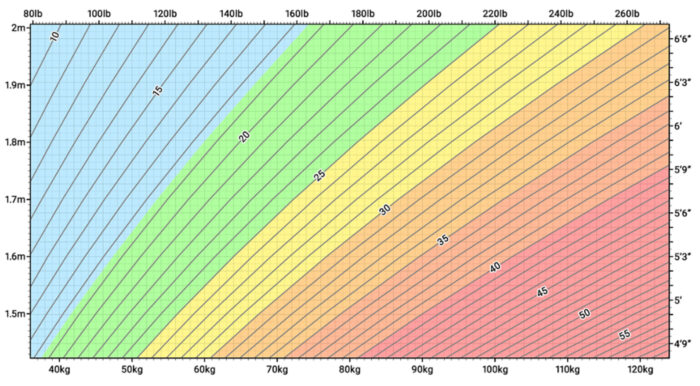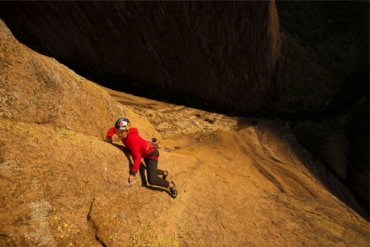Competitive climbing has a problem with eating disorders. That’s the message from both climbers and officials during a year of complaints and accusations against those in charge of the sport’s biggest organizations.
Two medical officials at the International Federation of Sport Climbing (IFSC) resigned this summer over frustration with the organization’s reluctance to implement screening measures. This year, USA Climbing began testing athletes for eating disorders. But, several experts say its current tests are insufficient to actually detect climbers with a problem.
Meanwhile, professional climbers like Janja Garnbret and Alannah Yip have sounded the alarm that eating disorders have become widespread in the sport and demanded increased testing.
“In a sport where you are fighting gravity, weight clearly plays a role,” Yip wrote on Instagram.
For climbers with an eating disorder, increased testing could put their careers in jeopardy. But in truth, the stakes are much higher: Eating disorders have the second-highest mortality rate of any mental illness. So, detecting athletes with this condition could do more than just maintain the integrity of competitions — it could literally save lives.
To understand how climbing officials should conduct testing, GearJunkie interviewed three experts with over 25 years of combined experience treating athletes with eating disorders.
They said increased testing could help climbers who need it. But, how to institute that testing? The answer, it turns out, might be as tricky as any elite-level boulder problem.
Eating Disorders in Climbing
While some aspects of eating disorders remain constant, the condition is far more diverse than many people realize.
Riley Nickols, a counseling and sports psychologist based in St. Louis, has been treating and researching athletes with eating disorders for over 10 years — including climbers. Like cycling or wrestling, competitive climbing has elements that can worsen an eating disorder, he said.
At times, going without food and water can start as something pragmatic, like during a long climb up a tall mountain, Nickols said.
“Then there’s also the reality that your body is a vessel in climbing, and sometimes there’s this notion that lighter is better or advantageous,” he said. “Sometimes that can run wild and be normalized, and go sideways for some athletes in the sport.”
While there’s not enough data to measure the prevalence of eating disorders in climbing specifically, it’s increasingly common in professional sports in general. Up to 13.5% of athletes struggle with an eating disorder, according to a 2013 study. It’s also common for both men and women (45% of female athletes and 19% of male athletes), according to a 2018 study co-authored by Nichols.
Testing for eating disorders should be about protecting these athletes, Nickols said, especially because they don’t always confer a competitive advantage.
“It’s not fair to unilaterally say that an eating disorder is only to get performance benefits,” Nickols said. “Sometimes it becomes an impediment to performance … This is a mental health condition that doesn’t always make logical sense.”
Body Mass Index (BMI) testing is especially problematic for athletes because their bodies already exist outside of the norm, he said.
“People at all BMIs can and do have eating disorders. I work with athletes with high BMIs that have severe eating disorders,” he said. “Using that test really dismisses those people’s struggles.”
Eating Disorders in Climbing: ‘A Dirty Little Secret’

Janja Garnbret — arguably the greatest competitive climber right now — first raised the issue of eating disorders in December during an interview at an IFSC event.
She said climbing organizations should institute testing procedures for eating disorders. Garnbret asked her social media followers: “Do we want to raise the next generation of skeletons?”
Fast-forward to this summer, when two doctors resigned from the IFSC over accusations that the group’s leaders failed to protect athletes suffering from RED-S, a broader medical category that includes those with eating disorders.
That’s also when another professional climber, Alannah Yip, called climbing’s “systemic weight problem” a “dirty little secret.” She urged the IFSC to require more medical testing before athletes can compete.
In the December interview, Garnbret emphatically supported the idea of increased athlete testing using BMI. And this year, USA Climbing began using BMI as part of its screening for detecting competitive climbers with eating disorders.
The IFSC, in contrast, dropped the use of BMI testing, prompting Yip to call for its return, along with additional testing.
However, according to eating disorder experts interviewed by GearJunkie, the procedures in place at both the IFSC and USA Climbing aren’t enough to make any real difference in detection. It’s good to see climbing organizations taking eating disorders seriously, they said, because many organizations aren’t doing anything at all.
But if the goal is to help climbers with eating disorders, testing based primarily on BMI remains problematic — at best.
“I can understand the rationale, and maybe it’s better than nothing,” said Nickols. “For those of us in this world, the over-reliance on BMI makes us want to bang our head against the wall … It’s maddening that BMI is still used in this way.”
Problems With BMI

In the simplest terms, Body Mass Index compares a person’s weight to their height. A high number can indicate a person is overweight, while a low number might suggest the opposite.
However, the test was always meant as a tool for categorizing populations — not for diagnosing the health of individuals. For example, many athletes register as “overweight” on the BMI scale because they have far more muscle mass than average.
And it’s especially “fraught” for athletic testing because most people with eating disorders have what’s considered “normal weight,” according to Jillian Lampert. Lampert is the chief strategy officer for The Emily Program, an eating disorder treatment center.
“With BMI testing, people get told they’re above or below 19-25, and things move on. And we only worry about people outside of that,” Lampert said. “That’s not going to help anybody.”
Lampert, as well as the other experts interviewed for this story, believes that athletic organizations should expand testing.
“I applaud the idea of screening athletes more thoroughly,” she said. “I can’t tell you how many athletes have a heart rate of 40, and they say everyone told them it’s fine. Having a heart rate of 40 is not the mark of a great athlete. It’s the mark of an undernourished person.”
However, Lampert would prefer the focus move away from only detecting eating disorders and toward a larger medical category called RED-S, or Relative Energy Deficiency in Sport. Put simply, RED-S applies to any person not eating enough calories to support the amount of energy they’re using.
As with eating disorders, RED-S can cause disrupted menstrual cycles, frequent illnesses, gastrointestinal upset, and deterioration of nearly every bodily system.
To develop reliable assessments for finding athletes suffering from RED-S, the International Olympic Committee (IOC) tapped specialists that Lampert calls “the best people in the field.” Those specialists delivered a report in 2018 offering detailed instructions for how athletic organizations can conduct these assessments.
So far, few organizations have implemented that assessment, including USA Climbing and the IFSC.
But, that could soon change.
USA Climbing Starts Testing Athletes
During the 2023 climbing season, which includes competitions around the world, USA Climbing began testing climbers for eating disorders.
The screening procedures include three main parts:
- A questionnaire that asks athletes their views about weight, performance, and their relationship with food
- A mental health assessment called the SMHAT-1
- A BMI test
USA Climbing will not use the BMI test as a way to diagnose climbers, said Zack DiCristino, the organization’s national team physical therapist and medical manager.
However, the number is part of how officials decide if “an athlete should then undergo further evaluation to determine their health status,” DiCristino said in an email.
If an athlete is flagged during the screening as potentially at risk for an eating disorder, they must undergo additional testing. That would include a battery of tests, including body fat percentage, bone mineral density, blood labs, and specific hormone levels. Athletes will also be required to complete two eating-behavior questionnaires.
At that point, USA Climbing officials would decide if the athlete could still compete.
The effectiveness of this system has yet to be determined. So far this season, no USA Climbing athletes have been denied the ability to compete. In fact, none of them have even been flagged during the initial screening, according to DiCristino.
Yet USA Climbing is already considering an update of those screening procedures based on recommendations from the IOC, DiCristino said.
“We are currently waiting to learn the results of a new research project specifically about RED-S, which may include an improved assessment tool and refined battery of the most valuable tests,” DiCristino said in an email. “Once we learn of these recommendations, our medical committee will refine our protocol based on the most recent evidence.”
As for the IFSC, they did not respond to requests for comment.
Is Reliable Testing Doable?
There’s a simple reason that eating disorder experts love the RED-S assessment released by the IOC in 2018. The tests are extremely comprehensive.
RED-S began as an investigation into the so-called Female Athlete Triad. This is a combination of eating disorders, low bone density, and missed or irregular periods. However, the 2018 IOC report now suggests that medical professionals look for 10 impacts of RED-S on the body. These include cardiac issues caused by decreased glycogen to psychological factors like depression.
It’s vastly superior to just looking at BMI, said Rebecca McConville, a dietician focused on athletes with eating disorders. In her book “Finding Your Sweet Spot,” McConville argues that weight can’t be used to determine a person’s relationship with eating or energy balance.
“If you’re only going off of weight or other indicators like menstrual cycles or bone-stress injuries, you’re going to miss the larger problem for many athletes,” McConville said. “The IOC assessment is the best tool available right now. The question is: Why are they not using it?”
According to Lampert, the answer might be simple. It won’t be easy (or cheap) to conduct such thorough testing of every single athlete. When a climbing event involves hundreds of competitors, the financial and organizational cost of conducting such tests could quickly become overwhelming, Lampert said.
“On an individual level, I’m not sure that the RED-S is practical to implement across a huge field of athletes,” she said.
That’s why it’s probably a good idea to start with faster screenings. These allow medical professionals to triage athletes based on their likelihood of having a RED-S issue. The mental health and BMI assessments currently used by USA Climbing aren’t ideal, but they’re better than nothing, Lampert said.
“Maybe USA Climbing can learn,” she said. “They’re learning a lot faster than skating and skiing. They’re learning quicker to get safety and screening procedures in place. But they still need to be better.”
The Power of Sport

While earning her Ph.D. in public health nutrition, Lampert used her dissertation to conduct research about young people in weight-focused sports, like cross-country running, ballet, dance, and wrestling.
She reached a surprising conclusion. Children in those sports were less likely to have issues than children who weren’t involved in sports at all.
“Early on in their sport trajectory, they were protected,” she said. “Once you’re at an elite level of the sport, it’s tough for everybody. That elite level of competition leads people to do things that can put them at risk.”
In her experience, athletes with eating disorders often improve when they can talk to another athlete with an eating disorder.
“That helps them work through the recovery process,” she said. “That group therapy is where the magic happens.”
As sports like competitive climbing try to confront eating disorders, it’s crucial to remember that it shouldn’t only be the responsibility of climbing organizations, she said. Climbing teams should improve their messaging as well, telling athletes that “quality performance” means taking care of their bodies — inside and out.
“It’s a huge societal change that has to happen to make this better,” she said. “We have to let go of the belief that thinner is better. Across the board. Right now, our culture encourages people to do crazy shit, in their eating, with their bodies. And lots of kids look up to the athletes who behave that way.”
As for McConville, she was recently reminded just how high the stakes are for athletes with eating disorders.
“I was doing a race with my daughter, and one of my clients was there,” she said. “She said to my daughter, ‘Your Mom saved my life’ … That really reinforces that athletes are human. We get caught up in the performance part and forget that.”







